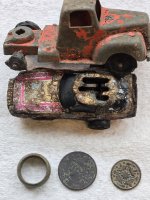SandomingoJim
Jr. Member
- Sep 8, 2016
- 55
- 52
- Detector(s) used
- Minelab GM 1000, Whites Goldmaster II, Tesoro Bandido II
- Primary Interest:
- Prospecting
Hello
I have a question for those that are familiar with the San Domingo gold placer area of Arizona. I have noticed over the years of prospecting the area the gravels are predominantly angular and not rounded by water action. Although surrounding areas not too far away show much rounded river rock on the surface. On occasion I will find a nice smooth cobble amidst the hard pack angular gravels which makes me wonder if an old river channel lies beneath the newer volcanic deposits. I would love to hear anyone's thoughts on the subject.
Thanks
Jim
I have a question for those that are familiar with the San Domingo gold placer area of Arizona. I have noticed over the years of prospecting the area the gravels are predominantly angular and not rounded by water action. Although surrounding areas not too far away show much rounded river rock on the surface. On occasion I will find a nice smooth cobble amidst the hard pack angular gravels which makes me wonder if an old river channel lies beneath the newer volcanic deposits. I would love to hear anyone's thoughts on the subject.
Thanks
Jim
Upvote
0








